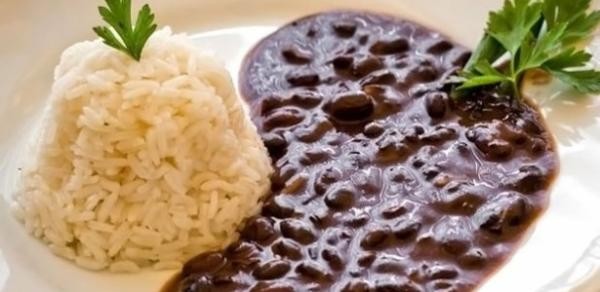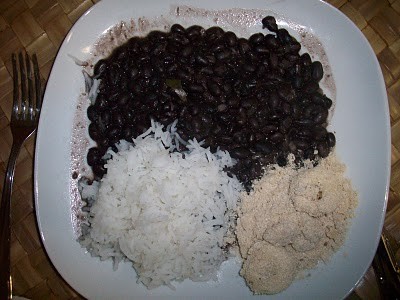Cooking at home (part four)
Hello!
Today I am going to tell you about another recipe that you can make easily, cheaply and quickly at home: you will see how easy it is.
It is a Brazilian recipe but don't worry, the ingredients are easy to find, wherever you are.

We are going to learn how to cook rice with black beans. For those who don't know Portuguese, 'el feijao' (black bean) is the thing that we call peas or beans, depending on the area of Spain you are from. For us it is more common to cook white beans and in Brazil it is more common to cook black or red beans. Already, you can see that the flavour is very different.
I never used to like it when my mother would cook them, however, after meeting my boyfriend and trying the black beans, I now ask him to make them for me because I love them so much.

Firstly, here is the list of ingredients:
- Half an onion
- Two or three cloves of garlic
- Chorizo in small cubes
- A piece of whole chorizo
- A box of bacon in small cubes
- A tin of black or red beans
- Salt (to your taste)
- Four teaspoons of olive oil
- A cube of stock
First of all, we make the rice but as I already explained how to do so in my recipe for Strogonoff, I will give the direct link so that you can read it there and I don't have to repeat the same thing.
As you can see, Brazilians use white rice with a mountain of recipes hehehe.
https://erasmusu.com/es/blog-erasmus/recetas-erasmus/cocinando-en-casa-3-parte-130994
You will find it at the end of the recipe, after the instructions for the Strogonoff.
Once you have made the rice, move on to the beans.
If you have a pressure cooker, buy normal beans in a glass jar or plastic packet and leave them to soak for a whole night. This way you only need to cook them for 20 minutes.
However, as the idea is to follow the recipe coming from Erasmus I highly doubt that anyone is going to have a pressure cooker, so I will explain it step by step with a normal cooker.
First, instead of buying raw beans, buy them in a preserved can which come half cooked and this way you will save energy in the kitchen when you come to cook them, or gas, depending on what type of kitchen you have.
Peel the onion and cloves of garlic and cut them up into little pieces.
Cut a piece of chorizo into little cubes, as much as you would like. If you have bought the little boxes of these that are spiced, add more or less half a box.
In a pan with a little oil, add the garlic and onion to the flame and when they start to brown add the little cubes of chorizo and the packet of bacon (also in little cubes). Stir it a few times until it has all browned.
When you cut the other piece of chorizo, cut it into little slices.
Once everything has browned, throw in the beans and add the cube of stock, a little salt, two bay leaves and the chorizo that you have cut into slices.
Take care with the quantity of salt, as the chorizo and the stock are already a little salty.
The slices of chorizo are optional, however, by cooking the fried part and the freshly cooked part, you are adding two different tastes and it is very good.
Lastly, add a little water until the beans are covered and leave them to cook for 20-30 minutes.
Depending on whether you like more or less broth, you should leave them more or less time, respectively.
However, the idea is that it remains thick, not too much liquid like you would usually do when making Spanish white beans.
When you serve it, serve it with a little rice on one side of the plate and a little bit of the beans on the other and mix it together as you eat it.
You can eat it alone or accompanied with a fillet of any type of meat.
Also, it is common to throw in a little farofa (a toasted cassava flour mixture), but this can be difficult to find if you are not in Portugal or if you are looking in a supermarket for these types of international flavours and world foods.
It is very common to eat it at barbecues, like a garnish with all types of meat, but it is a dish that is usually eaten daily in Brazil. As you can see it is a very cheap dish and it is not very complicated to make, so it is ideal for Erasmus students hehehe.
Also, with a large tin of the beans you can make enough food for four people. There are two of us and we eat this dish for two consecutive days because the we cannot fit it in the freezer, and we don't want to waste anything.
I hope that you are going to find this useful and that it goes well for you.
I will be back with new recipes!
Goodbye everyone!
Photo gallery
Content available in other languages
- Español: Cocinando en casa (4º parte)
- Français: Cuisiner à la maison (4ème partie)
- Italiano: Cucinare a casa (parte 4)
Want to have your own Erasmus blog?
If you are experiencing living abroad, you're an avid traveller or want to promote the city where you live... create your own blog and share your adventures!
I want to create my Erasmus blog! →





Comments (0 comments)